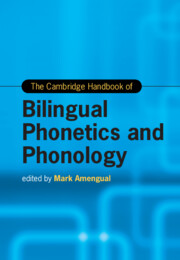Book contents
- The Cambridge Handbook of Bilingual Phonetics and Phonology
- Cambridge Handbooks in Language and Linguistics
- The Cambridge Handbook of Bilingual Phonetics and Phonology
- Copyright page
- Dedication
- Contents
- Figures
- Tables
- Contributors
- Acknowledgments
- Introduction Bilingual Phonetics and Phonology
- Part I Approaches to Bilingual Phonetics and Phonology
- Part II Theoretical Models of Bilingual Phonetics and Phonology
- Part III The Phonetics and Phonology of the Bilingual Child
- Part IV The Phonetics and Phonology of the Bilingual Adult
- Part V The Diversity of Bilingual Speakers
- Part VI Variables and Outcomes of Bilingual Speech
- 29 Language Dominance Effects in the Phonetics and Phonology of Bilinguals
- 30 Code-Switching and Language Mode Effects in the Phonetics and Phonology of Bilinguals
- 31 Orthographic Effects in the Phonetics and Phonology of Second Language Learners and Users
- 32 Phonetic and Phonological L1 Attrition and Drift in Bilingual Speech
- 33 Bilingual Speech Intelligibility
- 34 Using a Characteristic Speech Production (CSP) Procedure to Elicit Monolingual and Bilingual Speech
- 35 Bridging the Gap between Bilingual Phonetic Research and Pronunciation Teaching
- Index
- References
32 - Phonetic and Phonological L1 Attrition and Drift in Bilingual Speech
from Part VI - Variables and Outcomes of Bilingual Speech
Published online by Cambridge University Press: 14 November 2024
- The Cambridge Handbook of Bilingual Phonetics and Phonology
- Cambridge Handbooks in Language and Linguistics
- The Cambridge Handbook of Bilingual Phonetics and Phonology
- Copyright page
- Dedication
- Contents
- Figures
- Tables
- Contributors
- Acknowledgments
- Introduction Bilingual Phonetics and Phonology
- Part I Approaches to Bilingual Phonetics and Phonology
- Part II Theoretical Models of Bilingual Phonetics and Phonology
- Part III The Phonetics and Phonology of the Bilingual Child
- Part IV The Phonetics and Phonology of the Bilingual Adult
- Part V The Diversity of Bilingual Speakers
- Part VI Variables and Outcomes of Bilingual Speech
- 29 Language Dominance Effects in the Phonetics and Phonology of Bilinguals
- 30 Code-Switching and Language Mode Effects in the Phonetics and Phonology of Bilinguals
- 31 Orthographic Effects in the Phonetics and Phonology of Second Language Learners and Users
- 32 Phonetic and Phonological L1 Attrition and Drift in Bilingual Speech
- 33 Bilingual Speech Intelligibility
- 34 Using a Characteristic Speech Production (CSP) Procedure to Elicit Monolingual and Bilingual Speech
- 35 Bridging the Gap between Bilingual Phonetic Research and Pronunciation Teaching
- Index
- References
Summary
This chapter presents an overview of what is currently known about phonetic and phonological first language (L1) attrition and drift in bilingual speech and introduces a new theory of bilingual speech, Attrition & Drift in Access, Production, and Perception Theory (ADAPPT). Attrition and drift are defined and differentiated along several dimensions, including duration of change, source in second language (L2) experience, consciousness, agency, and scope. We address why findings of attrition and drift are important for our overall understanding of bilingual speech and draw links between ADAPPT and well-known theories of L2 speech, such as the revised Speech Learning Model (SLM-r), the Perceptual Assimilation Model-L2 (PAM-L2), and the Second Language Linguistic Perception model (L2LP). The significance of findings revealing attrition and drift is discussed in relation to different linguistic subfields. The chapter raises the question of how attrition and drift potentially interact to influence speech production and perception in the bilingual’s L1 over the life span; additional directions for future research are pointed out as well.
Keywords
- Type
- Chapter
- Information
- The Cambridge Handbook of Bilingual Phonetics and Phonology , pp. 721 - 745Publisher: Cambridge University PressPrint publication year: 2024
References
- 2
- Cited by

